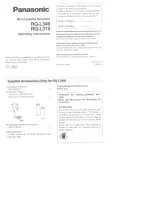
18
The First Session
MD4—Owner’s Manual
About Monitoring
MD4 features a flexible monitoring system, allowing you to monitor signals at various points.
You can monitor sounds through a pair of stereo headphones connected to the PHONES jack,
or through a monitor amplifier and speakers connected to the MONITOR OUT jacks. The
MONITOR SELECT switches are used to select the monitor source, and the MONITOR LEVEL
control is used to adjust the level.
GROUP
—These switches select the Group buses as the monitor source. This allows you to
monitor signals that are assigned from input channels, AUX RETURN, or the STEREO SUB IN
to tracks for recording. Use these switches to monitor what will be recorded. For example, if
you’re recording the sounds from three input channels to one track simultaneously, you’ll need
to listen to a mix of the three sounds in order to balance the levels correctly. You can do this
using the GROUP switches.
When only the [1–3] or [2–4] MONITOR SELECT GROUP switch is pressed, the monitor sig-
nal is set as mono. This ensures that the signal being monitored appears in both the left and
right monitor speakers. So even when you monitor a single group signal, it will be heard
through both speakers. When both the [1–3] and [2–4] MONITOR SELECT GROUP switches
are pressed, however, the monitor signal is set as stereo. So you can monitor stereo signals on
Groups 1 and 2 or Groups 3 and 4.
STEREO
—This switch selects the Stereo bus as the monitor source. This allows you to monitor
the STEREO OUT signals and is typically used during mixdown. It can also be used to monitor
signals that are not going to be recorded by MD4, such as a MIDI tone generator that is con-
trolled by a MIDI sequencer. In this case, the tone generator is only monitored while other
sounds are recorded on MD4. Then for the final mixdown, the tone generator sounds are mixed
with the sounds recorded on MD4 and mixed down to a stereo master recorder.
CUE
—This switch selects the CUE bus as the monitor source. This allows you to monitor track
signals. Unlike the other monitor sources, the CUE monitor source changes when MD4 starts
recording or rehearsing. For example, during normal playback CUE allows you to monitor the
sounds recorded on disc. Obviously, if nothing is recorded, there’s nothing to monitor. When
either record or rehearse is started, however, CUE allows you to monitor the sounds that are
assigned to tracks for recording. The application of this may not appear very obvious at the
moment, but all will become clear in the punch in/out and ping-pong recording sections.
Note: Although you can monitor GROUP, STEREO, and CUE all at the same time, there is
a possibility that you’ll monitor the same signal from two different points in the signal flow.
At first, you may find it less confusing to select just one monitor source at a time.
















































